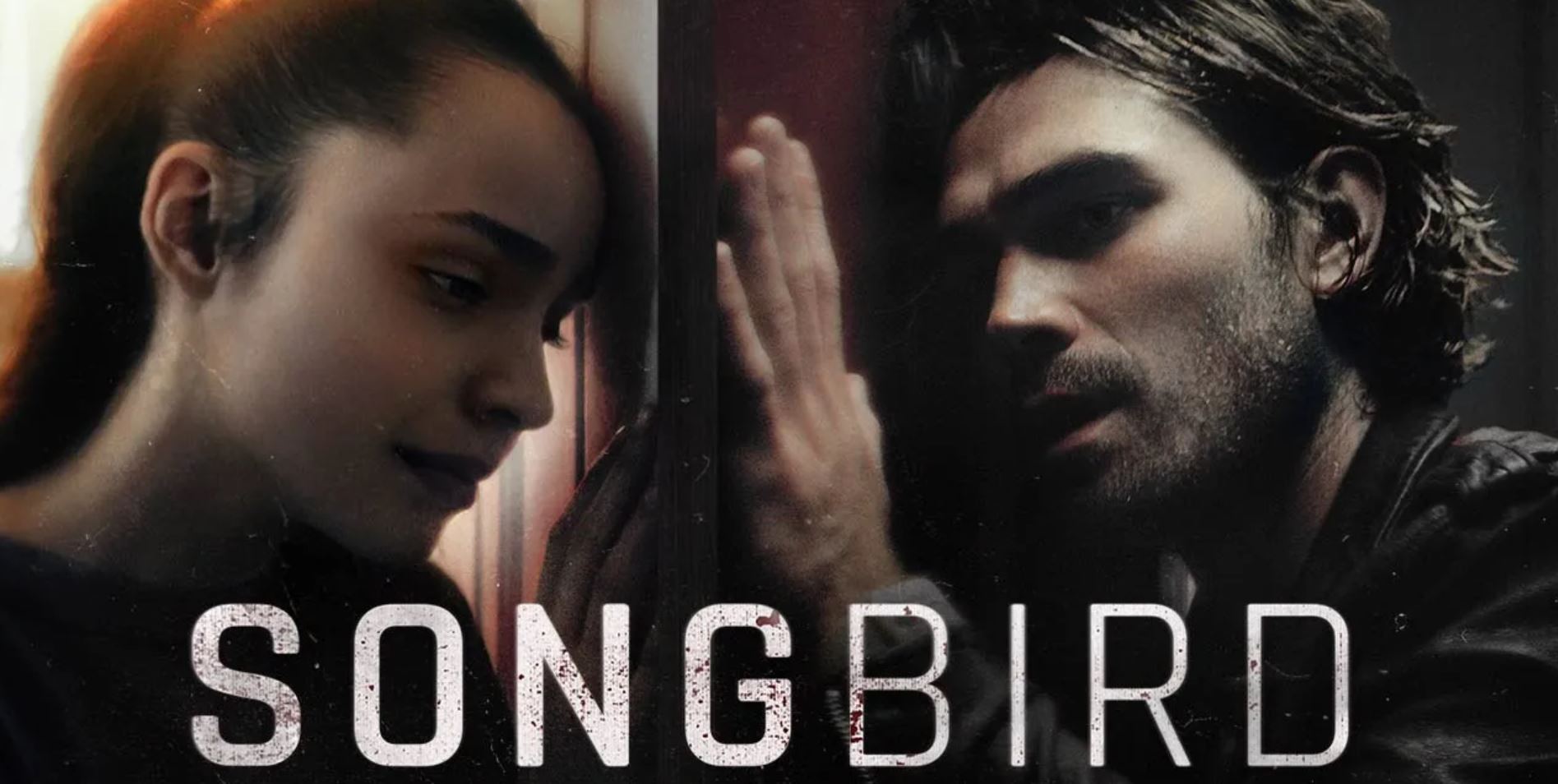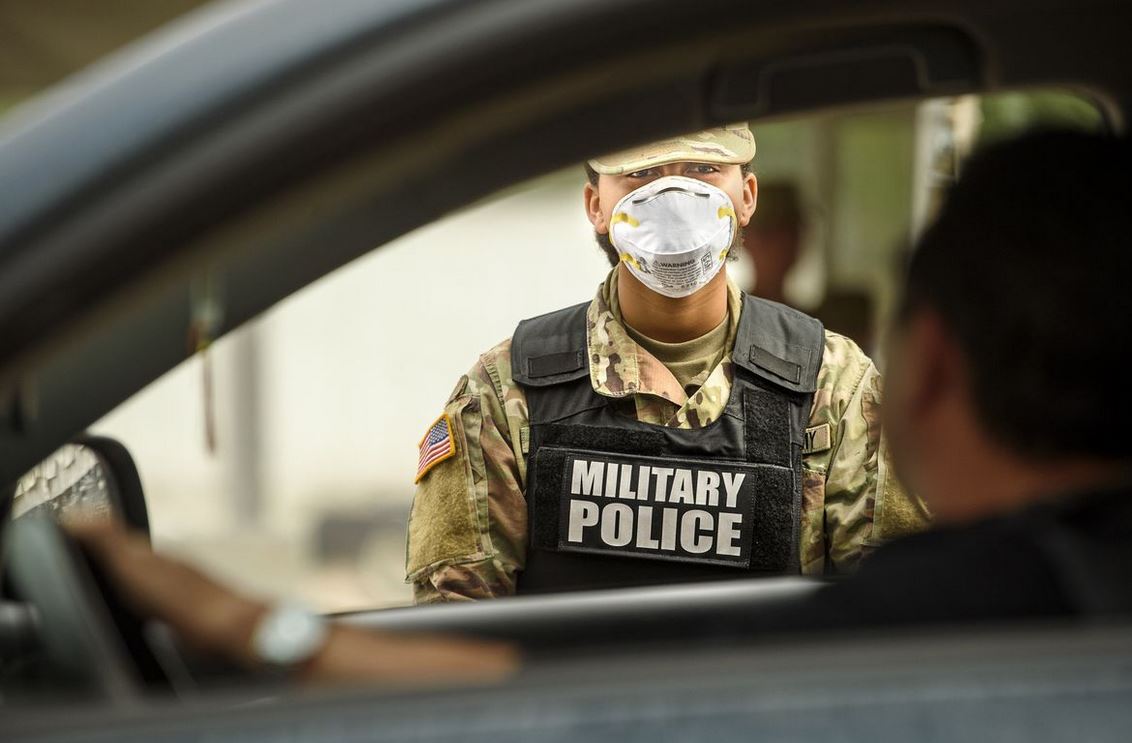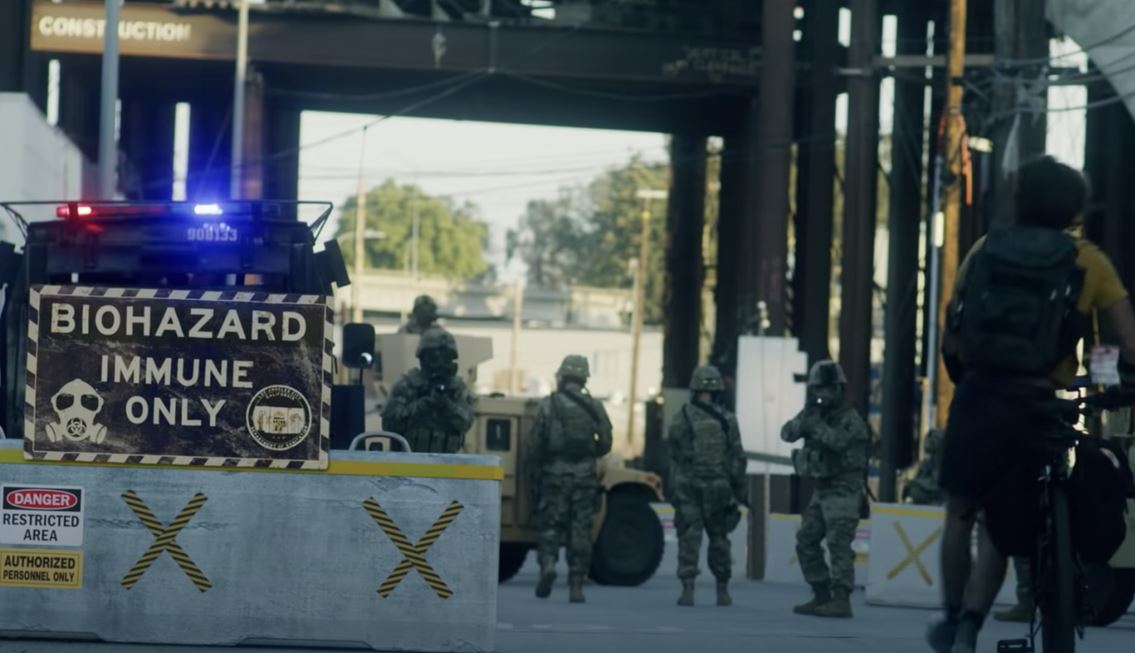 By B.N. Frank
By B.N. Frank
How your life has been affected by COVID-19 depends on where you live. While reports of inaccurate tests continue to increase (see 1, 2), and at least one person suffered a serious injury from a nasal swab test, mandates continue to be issued and/or extended for additional testing, restrictions, and surveillance.
New, invasive, and unsafe technology has been and continues to be invented, deployed, and worn in an effort to detect illness and prevent its spread. This includes wearables worn by American military personnel, employees (see 1, 2), school children and staff as well as expensive temperature scanning technology installed at schools and universities. There are credible skeptics who say this can be more hurtful than helpful. Experts continue to warn about the obvious privacy and safety risks with all of this. Depending on who you ask – the “cures” are worse than the illness.
A soon-to-be released fictional film captures the essence of all of the above.
From GreenMedInfo:
‘216TH WEEK OF LOCKDOWN’ – New COVID Film SONGBIRD Scares the Hell out of People Because It May Not Be Entirely Fiction
By:GMI Reporter
The soon-to-be-released film Songbird is the first major project out of Hollywood since the lockdowns began, and it smacks of predictive programming, trauma-based mind control, and a disturbing blurring of the lines between fact and fiction.
“Predictive programming is a subtle form of psychological conditioning provided by the media to acquaint the public with planned societal changes to be implemented by our leaders. If and when these changes are put through, the public will already be familiarized with them and will accept them as natural progressions, thus lessening possible public resistance and commotion.” ~ Alan Watts
Indeed, Songbird is not deeply disturbing because it stretches the imagination into shockingly novel and unthinkable territory, as is to be expected from fiction, but rather, it sends chills up the spine because it speaks to what many of us are already horrified to have seen and believe will likely continue to see happening around us, in the name of “protecting the public against deadly viruses.”
In fact, many of the terrifying scenes within the film’s trailer will already be familiar to the public because have already been seeded and administered in shocking doses by the Chinese and global media, such as images of citizens dropping dead in the streets, being forcibly removed from their homes by militarized medical police, or the soldering shut of buildings to keep newly quarantined citizens inside their homes-become-lockdown cells.
It is conspicuous that Songbird somehow received approval to be the first feature film to be made during COVID-19 in Los Angeles when virtually all other major products were forbidden from continuing. Also, STX Entertainment’s top investors include Chinese companies such as Tencent, a multinational technology conglomerate holding company which includes medical and artificial intelligence divisions, and Hony Capital, which has direct investment ties to the Bill & Melinda Gates Foundation.
Here is STX Entertainment’s telling description of the film:
“In the terrifying thriller SONGBIRD, the COVID-23 virus has mutated and the world is in its fourth year of lockdown. Infected Americans are ripped from their homes and forced into quarantine camps known as Q-Zones, from which there is no escape, as a few brave souls fight back against the forces of oppression. Amid this dystopian landscape, a fearless courier, Nico (KJ Apa), who’s immune to the deadly pathogen, finds hope and love with Sara (Sofia Carson), though her lockdown prohibits them from physical contact. When Sara is believed to have become infected, Nico races desperately across the barren streets of Los Angeles in search of the only thing that can save her from imprisonment … or worse.
The first feature film to be made during COVID-19 in Los Angeles, and about the pandemic itself, SONGBIRD also stars Bradley Whitford and Demi Moore as a wealthy couple who may hold the key to Nico’s mission; Alexandra Daddario as a singer enmeshed in a messy and forbidden affair; Paul Walter Hauser as a disabled veteran whose best friend – a drone named Max – is his eyes and ears to a world that has left him behind; Craig Robinson as Nico’s boss; and Peter Stormare as the corrupt head of the city’s “sanitation” department, which seizes those infected and transports them to the Q-Zone.”
Songbird could be viewed as the perfect merger of predictive programming and trauma-based mind and behavioral control, the latter of which has long been used by private and public sectors in partnership (e.g. the CIA’s Operation Mockingbird which manipulated news media for propaganda purposes), or alone, to leverage media assets in such a way as to produce changes in mass behavior, thought, and emotion.
Even if there is absolutely no “hidden agenda,” or intention to produce a film that will affect the mind and behavior of the masses, by scaring the living hell out of people with worsening global scenarios, such as the “216th straight week” of lockdown, and the coining of a COVID-23 strain, indicative that in 2023 and beyond things will likely be far worse than they already are (reminiscent of the “endless war on terror,” but with viruses taking on the role of bioterrorists), it accomplishes several things that may have value for those who have architected and implemented what many have termed a planned epidemic, i.e. Plandemic.
First, if things continue to spiral downward as depicted in Songbird, and civil liberties remain suspended or more egregious violations occur (e.g. mandatory vaccination; forcible internment), when the atrocities depicted in the film do come to pass, there may be less resistance among those affected, because the “shock” and subsequent disassociation created by the film will generate an immediate, albeit surreal sense of narrative recognition, a déjà vu which follows the unfolding of events that have been preprogrammed into the psyche subconsciously, which then lead learned helplessness and passivity when similar events actually unfold in reality.
Or, conversely, if the worst-case scenarios described in the film do not come to pass, they provide a psychic reference frame for what “could have been much worse,” rendering the civil and human rights violations actually happening right now to be perceived as less egregious and more likely to generate complacency.
Either way, the film would accomplish both a certain shock-induced emotional release, as well as subsequent anesthetizing effect on the public. This could be considered the perfect formula for co-opting an already media-addicted population who may never before in human history, be less prone to believing the actual evidence of their own eyes in favor of what is presented to them as the “official narrative” through the mainstream media, with the line between fiction and fact become every increasingly blurred, if not entirely erased. Songbird, therefore, becomes the perfect intentional or accidental tool of Operation Mockingbird.
Is Songbird Fiction or Predictive Programming? Are the CDC’s COVID-19 “Green Zones” Theoretical or Intended to be Implemented?
In Songbird, we know that there are so-called “Q-Zones” set up to confine those suspected to be at risk of being infected, or who are infected. This “fictional scenario” bears eerie resemblance to scenarios called “Green Zones” described on the CDC’s website.
The CDC recently released guidelines on the implementation of what amounts to COVID-19 internment or preventive confinement camps. The document, last updated on July 26, 2020, can be found on their website and is titled, “Interim Operational Considerations for Implementing the Shielding Approach to Prevent COVID-19 Infections in Humanitarian Settings.” It proposes a set of guidelines for the establishment of so-called “green zones” intended to segregate and quarantine “high risk” populations in order to implement a “shielding approach to COVID-19.”
According to the document, a shielding approach:
“…aims to reduce the number of severe COVID-19 cases by limiting contact between individuals at higher risk of developing severe disease (“high-risk”) and the general population (“low-risk”). High-risk individuals would be temporarily relocated to safe or “green zones” established at the household, neighborhood, camp/sector or community level depending on the context and setting.1,2 They would have minimal contact with family members and other low-risk residents.”
The so-called “high risk” group described in the document are, “older adults and people of any age who have serious underlying medical conditions are at higher risk for severe illness from COVID-19.”
The shielding approach would require physically separating high-risk individuals from the general population, in order to, “prioritize the use of the limited available resources and avoid implementing long-term containment measures among the general population.”
The three proposed options for containment/interment are labeled “green zones” and include: a) Household Level b) Neighborhood Level and c) Camp/Sector Level.
The CDC states that the shielding approach “necessitates strict adherence,” if it is to live up to its promises of protecting high-risk populations from disease and death, and acknowledges that, it could, in fact, make the situation worse through the inadvertent introduction of the virus into a green zone, which it says would result in rapid transmission among the most vulnerable populations the approach is trying to protect.
The CDC also acknowledges that this is a novel approach and that the idea for it comes from “humanitarian settings as outlined in guidance documents focused on camps, displaced populations, and low-resource settings. This approach has never been documented and has raised questions and concerns among humanitarian partners who support response activities in these settings. The purpose of this document is to highlight potential implementation challenges of the shielding approach from the CDC’s perspective and guide thinking around implementation in the absence of empirical data. Considerations are based on current evidence known about the transmission and severity of coronavirus disease 2019 (COVID-19) and may need to be revised as more information becomes available.”
The CDC’s document guidelines are based on two papers published in 2020 titled, “Guidance for the prevention of COVID-19 infections among high-risk individuals in camps and camp-like settings,” and COVID-19 control in low-income settings and displaced populations: what can realistically be done?
Both were published by the London School of Hygiene and Tropical Medicine – a heavily Gates and Melinda Foundation funded and influenced organization.
The CDC document also contains a subsection titled, “Timeline Considerations,” which sets up a plan for an “extended duration of implementation time, at least 6 months.”
The explanation provided for this extended duration is as follows:
“Explanation: The shielding approach proposes that green zones be maintained until one of the following circumstances arises: (i) sufficient hospitalization capacity is established; (ii) effective vaccine or therapeutic options become widely available; or (iii) the COVID-19 epidemic affecting the population subsides.
Given the limited resources and healthcare available to populations in humanitarian settings prior to the pandemic, it is unlikely sufficient hospitalization capacity (beds, personal protective equipment, ventilators, and staff) will be achievable during widespread transmission. The national capacity in many of the countries where these settings are located (e.g., Chad, Myanmar, and Syria) is limited. Resources may become quickly overwhelmed during the peak of transmission and may not be accessible to the emergency affected populations.
Vaccine trials are underway, but with no definite timeline. Reaching the suppression phase where the epidemic subsides can take several months and cases may resurge in a second or even third wave. Herd immunity (the depletion of susceptible people) for COVID-19 has not been demonstrated to date. It is also unclear if an infected person develops immunity and the duration of potential immunity is unknown. Thus, contingency plans to account for a possibly extended operational timeline are critical.” [emphasis added]
Notable information also referenced in the document are:
- Green zones would be “monitored and evaluated,” with dedicated staff to monitor adherence to protocols and potential adverse effects or outcomes due to isolation and stigma, as well as “if feasible, to minimize movement in/out of green zones.”
- Men and women would be “isolated separately.”
- So-called “High-risk minors” would be accompanied into isolation by a single caregiver who will also be considered a green zone resident in terms of movements and contacts with those outside the green zone.
- “High-risk individuals will be responsible for cleaning and maintaining their own living space and facilities. This may not be feasible for persons with disabilities or decreased mobility.”
While the two primary papers upon which the guidance is based focus on the application of these systems within non-developed or under-developed ‘humanitarian zones,” one wonders what would stop the CDC from employing this strategy domestically if, in fact, these interventions lived up to their promises and actually “saved lives.” After all, it was the “save lives” mantra that was used to shutter the national economy, and rendered most social behaviors either illegal or impossible to engage in, since the national lockdown began on March 15th.
Even if these guidelines were intended for the “non-US setting” (which they have not said), trusting that the CDC is either without duplicity, has our best intentions in mind, or is solely in control and charge of the unfolding COVID agenda, amounts to quite a leap of faith in times like ours. For example, the Pentagon recently announced that they instead of the CDC will be in charge of distributing and “deploying” COVID vaccines to the public. Sadly, this could be a sign of things come.
What is not conjecture and completely factual is that Songbird depicts COVID internment or confinement camps as “Q-Zones,” and the CDC provides a document that describes them as “Green Zones” — to be implemented somewhere in the world. This is just one example of how fiction and fact are increasingly blurred in the time of Covid. Is it any wonder people are running scared?
Another example of predictive programming can be found in a 2010 National Film Board of Canada predictive programming documentary OUTBREAK wherein is detailed the Government of Canada’s plans for a future outbreak and how it will roundup, mandate tracking bracelets, and put into detention centers those who refuse vaccination.
With films like Songbird leaving people feeling even more scared, traumatized and disempowered, the good news is there are positive actions you can take.

















